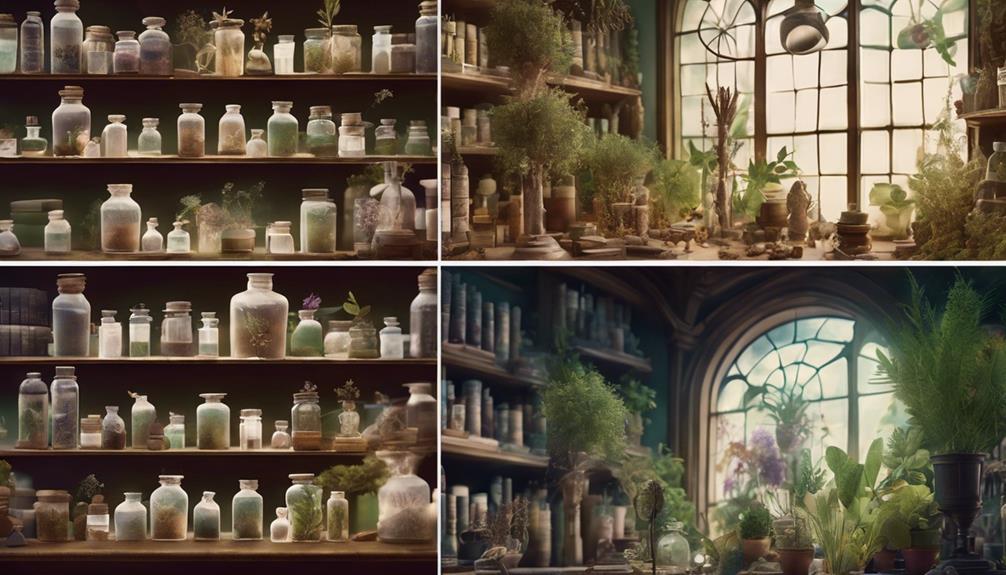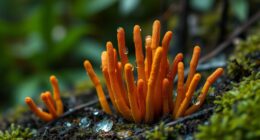As we start our herbalism journey, we're joining a thriving community of over 70% of the global population who rely on traditional medicine, with herbs playing a crucial role in preventative care and holistic well-being. To get started, we'll explore the basics of herbalism, understanding its holistic approach to well-being and learning about different types of herbalism. We'll research and experiment with herbs, empowering ourselves with self-care practices. By choosing the right herbs, understanding their properties, and sourcing them sustainably, we'll begin to grasp the medicinal power of herbs, and as we continue, we'll uncover the secrets of herbal remedies, growing our knowledge and skills.
Key Takeaways
• Start by exploring the basics of herbalism, understanding the holistic approach to well-being, and learning about different types of herbalism.
• Research and experiment with various herbs, considering their medicinal properties, therapeutic actions, and traditional uses.
• Select herbs thoughtfully, considering their properties, benefits, and potential interactions, and experiment with blends to create personalized remedies.
• Prioritize sustainable sourcing practices, learning about ethical wildcrafting, cultivation methods, and supporting reputable suppliers.
• Begin with simple herbal preparations like teas, tinctures, and salves, and practice making remedies to build confidence and deepen knowledge.
Getting Started With Herbalism
As we begin our herbalism journey, we'll start by exploring the basics of getting started with this ancient practice. Herbalism is more than just using herbs; it's a holistic approach to well-being that encompasses nourishing the whole person. We'll learn about the different types of herbalism, such as Ayurveda, Traditional Chinese Medicine, and Western herbalism, and how they've been passed down through generations.
When learning about herbs, we'll discover that it's not just about using plants for medicinal purposes, but also about understanding their role in promoting overall wellness. We can start by researching and experimenting with herbs, exploring gateway herbs, and building an herbalism library. With the abundance of free information available on platforms like YouTube, we can easily access knowledge and guidance from experienced practitioners.
As beginners, we can take the first step by studying herbs for personal use, and then expand into community or clinical herbalism. We'll learn when to consult professionals and how to empower ourselves with self-care and wellness practices.
Choosing the Right Herbs

As we explore the world of herbalism, we're now going to focus on choosing the right herbs for our needs. This involves identifying the properties of different herbs, selecting the right blends for specific purposes, and understanding the cycles of growth and harvesting.
Identifying Herb Properties
When selecting herbs for our herbal formulations, we must consider the medicinal properties and therapeutic actions of each herb to make sure we're choosing the right ones for our specific needs. This involves researching the properties of herbs, such as their taste, energetics, and actions, to understand their healing properties. We need to learn about the traditional uses and modern applications of herbs, as well as the organ systems they affect and their specific therapeutic benefits.
| Herb | Medicinal Properties | Therapeutic Actions |
|---|---|---|
| Ginger | Anti-inflammatory, Digestive | Relieves nausea, Soothes digestive issues |
| Peppermint | Cooling, Relaxing | Eases headaches, Improves digestion |
| Turmeric | Anti-inflammatory, Antioxidant | Reduces inflammation, Improves cognitive function |
| Chamomile | Calming, Soothing | Promotes relaxation, Improves sleep quality |
Selecting the Right Blends
To craft effective herbal blends, we need to thoughtfully select herbs that work harmoniously together to address specific health concerns. When combining herbs, we must consider the properties and benefits of each herb to guarantee they complement one another.
We should research the safety and interactions of herbs when combined to achieve best results. Additionally, we should take into account the taste and aroma of herbs to create a balanced and enjoyable blend.
Experimenting with different combinations of herbs allows us to find what works best for our individual needs. Seeking guidance from experienced herbalists or resources can also help us create effective and harmonious herbal blends.
By doing so, we can create blends that effectively address specific health concerns. For instance, combining herbs like peppermint, ginger, and chamomile can create a soothing blend for digestive issues.
Understanding Herb Cycles
We must examine the intricate cycles of herbs, from seasonal availability to growth and flowering patterns, to select the right ones for our herbalism practice. By understanding these cycles, we can choose herbs that provide maximum medicinal benefits.
For instance, we need to take into account whether an herb is an annual, biennial, or perennial, as this impacts when and how we harvest it. We should also study the life cycle of each herb to determine the best times for planting, harvesting, and utilizing them in our herbal preparations.
By doing so, we can maximize the medicinal benefits of each herb and build a deeper connection with the plants we work with. This knowledge is essential in herbalism, as it allows us to create effective remedies that truly harness the power of nature.
Understanding Herb Properties

As we delve into the world of herbalism, we're now going to examine the properties of herbs, which are essential in creating effective remedies.
We'll be looking at herbal actions, such as adaptogens, nervines, and carminatives, which influence how herbs interact with our bodies.
Herbal Actions
What makes herbs so effective in promoting healing and wellness is their unique properties, which are classified into specific herbal actions. As beginners learning about herbalism, understanding these properties is essential.
Herbal actions refer to the specific effects herbs have on the body, such as diuretic, anti-inflammatory, or sedative properties. By grasping these actions, we can select the right herbs for specific health concerns or conditions. For instance, adaptogens help our bodies adapt to stress, while nervines support the nervous system.
What's fascinating is that different herbs can have multiple actions, making them versatile in addressing various health issues. Take, for example, an herb like ginger, which has anti-inflammatory and digestive properties.
Plant Energetics
Delving into the domain of plant energetics, we uncover the intricate web of inherent qualities and characteristics that dictate an herb's therapeutic effects. In the world of herbal medicine, understanding plant energetics is essential for creating effective herbal formulations. We learn that each herb possesses unique properties, such as temperature, taste, and actions, which guide us in matching herbs with specific health conditions.
| Property | Description | Examples |
|---|---|---|
| Temperature | Hot or cold, influencing the body's energy | Ginger (hot), Peppermint (cooling) |
| Taste | Bitter, sweet, sour, etc., affecting the body's response | Dandelion (bitter), Licorice Root (sweet) |
| Actions | Stimulating, calming, or tonifying, depending on the herb | Ginseng (adaptogenic), Valerian (sedative) |
| Moisture | Moistening or drying, impacting the body's hydration | Aloe Vera (moistening), Sage (drying) |
Sourcing Herbs Sustainably

We take a significant step towards responsible herbalism by sourcing herbs sustainably, guaranteeing that our pursuit of natural wellness doesn't come at the expense of the environment.
When it comes to sourcing herbal products, we must prioritize sustainable practices to avoid depleting natural resources. This involves researching reputable suppliers who adhere to organic or FairWild certification standards, making sure that their sourcing practices are transparent and environmentally conscious.
As beginners, it's crucial to learn about ethical wildcrafting and cultivation methods to promote sustainable herb sourcing. We must also grasp the importance of protecting overharvested herbs and practice sustainable harvesting techniques to preserve the environment.
By supporting companies that prioritize sustainable practices, we can make a positive impact on the environment.
Let's educate ourselves and others about the significance of sustainable herb practices, and consider growing our own herbs or supporting local sustainable herb farms. By doing so, we can ensure a healthier planet while pursuing our goal of natural wellness.
Growing Your Own Herbs

As we commence our herbalism journey, cultivating our own herbs allows us to have complete control over the quality and freshness of our herbal remedies. Growing our own herbs is a great way to begin our herbalism journey, as it enables us to choose the herbs that best suit our health needs. We can select easy-to-grow herbs like basil, mint, and parsley for our herb garden, considering our climate and growing conditions when making our selection.
| Herb | Growing Conditions |
|---|---|
| Basil | Well-drained soil, full sun |
| Mint | Moist soil, partial shade |
| Parsley | Well-drained soil, partial shade |
Basic Herbal Preparations

Let's delve into the world of basic herbal preparations, where we can discover the medicinal potential of our homegrown herbs through teas, tinctures, salves, and infused oils.
As beginners, it's crucial to comprehend these fundamental preparations to fully tap into the potential of herbalism. Herbal teas are a great starting point, allowing us to integrate herbs into our daily routines in a simple and accessible way.
Tinctures, on the other hand, involve extracting medicinal properties from herbs using alcohol or glycerin, providing a concentrated form of herbal goodness. Salves and infused oils are perfect for topical applications and skincare purposes, offering a natural approach to skin health.
By mastering these basic preparations, we can experiment with different herbs and create personalized remedies tailored to our specific needs. With practice and patience, we'll be well on our way to harnessing the medicinal power of herbs.
Herbal Remedies for Beginners

Discovering the right herbal remedies for our specific needs begins with exploring gateway herbs like chamomile and lavender, which offer a gentle introduction to the world of herbalism. As beginners, we need to understand the properties and applications of common herbs to reveal their healing benefits.
Here are some essential steps to get us started:
- Build a herbal library: Collect helpful books that deepen our knowledge and skills in creating herbal remedies.
- Research and caution: Look into potential side effects and contraindications before using herbs to reveal safe and effective remedies.
- Free resources: Utilize online platforms like YouTube to learn practical tips and techniques for making herbal remedies.
- Practice makes perfect: Start experimenting with simple herbal remedies, like teas and salves, to develop our confidence and skills.
Common Herbal Misconceptions

Exploring herbal remedies for beginners, we must recognize that herbalism isn't a pseudoscience, but a legitimate practice rooted in traditional medicine and modern research.
One major misconception is that herbal remedies are less effective than pharmaceutical drugs, but studies have shown the efficacy of many herbs in treating various health conditions.
Another misconception is that herbalism is unsafe, yet when used correctly and under guidance, herbs can be a safe and gentle way to support health.
Some believe that herbalism is only for alternative health enthusiasts, but it can be integrated into mainstream healthcare practices for a holistic approach to wellness.
Additionally, herbalism isn't a one-size-fits-all approach; it emphasizes individualized treatments based on a person's unique constitution and needs.
Next Steps in Herbalism

As we explore further into the world of herbalism, our next step is to bridge the knowledge gap by seeking out opportunities that foster growth and hands-on experience. We can start by exploring beginner-friendly herbalism courses online or in-person, such as the School of Natural Healing, to deepen our knowledge.
Here are some next steps we can take:
- Join local herbalism groups or workshops to connect with like-minded individuals and learn from experienced practitioners, like the Godmother of American Herbalism.
- Start a herbalism journal to document our learnings, experiences, and observations with different herbs.
- Experiment with creating simple herbal remedies at home using basic herbs like chamomile, lavender, or peppermint.
- Consider apprenticing with a local herbalist to gain hands-on experience and practical skills in herbalism.
Frequently Asked Questions
Can I Teach Myself Herbalism?
We can definitely teach ourselves herbalism. Many herbalists start with self-study, using books, online resources, and hands-on experimentation with herbs.
While it's beneficial to seek guidance from experienced practitioners, self-teaching allows us to learn at our own pace and explore our interests in-depth.
With dedication and a willingness to learn, we can develop a strong foundation in herbalism and continue to grow our knowledge over time.
How Do I Start Learning About Herbalism?
We're excited to commence on this herbal journey, and it begins with a simple step: starting small.
We'll begin by sifting through online resources and books to explore the properties, applications, and benefits of gateway herbs like peppermint and ginger.
This foundational knowledge will help us build a solid understanding of herbalism, and we can't wait to plunge in and discover the wonders of the plant world!
How to Start Herbalism Journey?
As we begin our herbalism journey, we start by researching and experimenting with herbs to familiarize ourselves with their properties and applications.
We start with gateway herbs, build a library of helpful books, and utilize free online resources like YouTube.
We also consult medical professionals when needed, ensuring a safe and informed journey.
How Long Does It Take to Become a Herbalist?
As we begin on this herbalism journey, it's like planting a seed – it takes time, nurturing, and patience to bloom into a skilled practitioner.
The time it takes to become a herbalist varies greatly, ranging from a few months to several years, depending on our dedication, learning methods, and the level of expertise we aim to achieve.
Online courses can provide a foundation in a few months, but ongoing learning and experience are essential for mastery.
Conclusion
As we conclude our journey into the world of herbalism, remember that the path to mastery is like tending a garden – it requires patience, dedication, and gentle nurturing.
With each step, we cultivate wisdom, just as the earth yields its secrets to our care.
May our exploration of herbalism's vast landscape inspire us to harvest the wisdom of the plants, and in turn, nourish our own growth and well-being.










